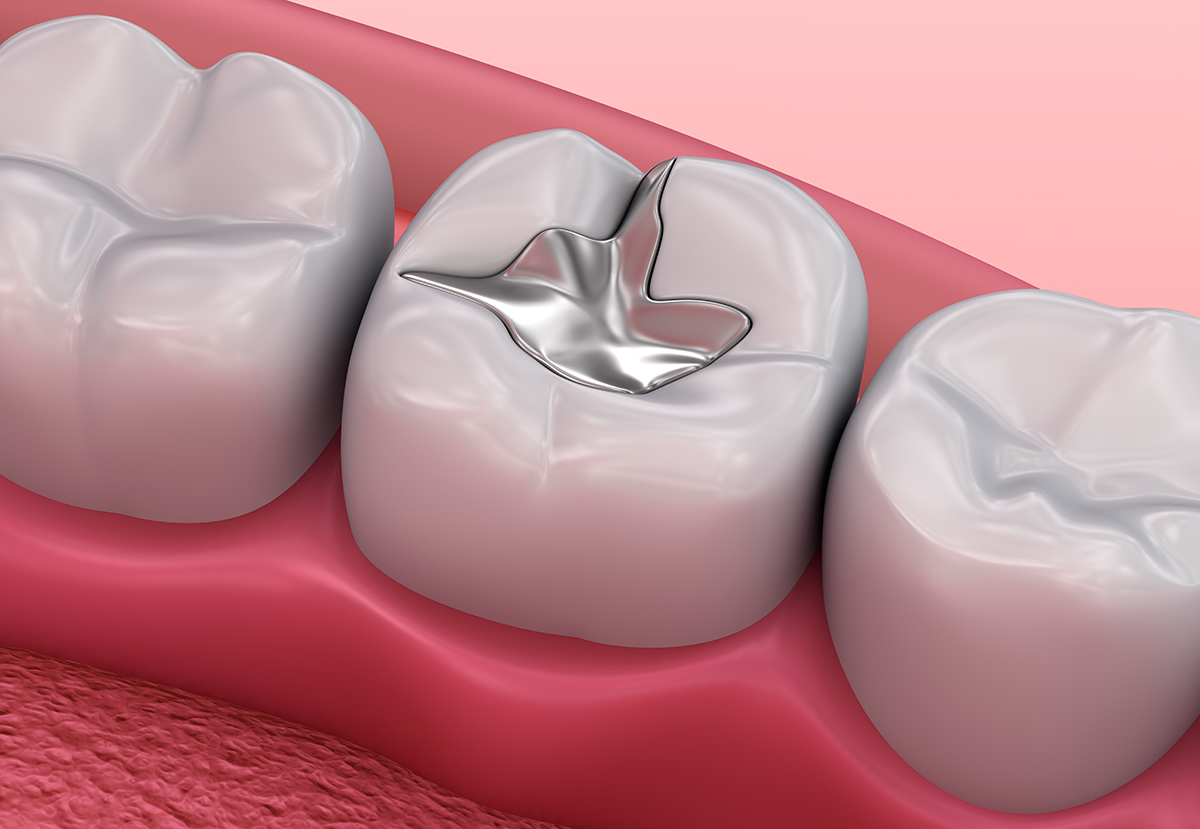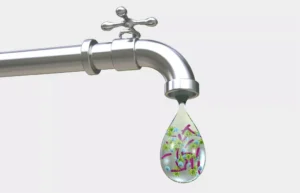 Mercury fillings have been a staple in dentistry for over 150 years. These fillings are a mixture of liquid elemental mercury (50% by weight) plus silver, tin, and copper (1). When someone has a cavity, the dentist removes the decaying part of the tooth and inserts the mercury filling in its place. In the past, I remember reading an article about mercury from the filling being released into our bodies when we chew our food. I recently went to the dentist, which may have re-sparked my interest in this topic. I really don’t know much about mercury being released into our bodies, but I do know there is considerable controversy around the topic. After finishing this blog, I am seriously considering getting my fillings removed.
Mercury fillings have been a staple in dentistry for over 150 years. These fillings are a mixture of liquid elemental mercury (50% by weight) plus silver, tin, and copper (1). When someone has a cavity, the dentist removes the decaying part of the tooth and inserts the mercury filling in its place. In the past, I remember reading an article about mercury from the filling being released into our bodies when we chew our food. I recently went to the dentist, which may have re-sparked my interest in this topic. I really don’t know much about mercury being released into our bodies, but I do know there is considerable controversy around the topic. After finishing this blog, I am seriously considering getting my fillings removed.
Amount of mercury in each filling
Mercury capsules are purchased with a set amount of mercury per capsule, typically ranging from 100 to 1,000 milligrams of mercury (2). The quantity of mercury in a filling is roughly equal to the amount of mercury in a thermometer.
Mercury-the unique metal
Are you curious as to why a metal would give off vapors at room temperature without having to be heated? Mercury is the only metallic element that is liquid at room temperature. It is also the metal with the lowest boiling point. When the mercury in the filling is disturbed, it can evaporate (as vapor) and be inhaled. Another interesting fact is that mercury, which is orally ingested, rarely causes acute toxic effects as less than 0.01% of the dose is absorbed by the gastro-intestinal tract (3). It would take about 100 grams of elemental mercury taken as a single dose to kill a 154-pound man! Mercury vapor, on the other hand, has about 100% bioavailability.
Daily release of mercury vapor
When I mentioned mercury being released from the filling, if you are like me, you probably imagined minute amounts of mercury dislodging from the filling and being swallowed. Or maybe you are wiser than me and know that the main concern is mercury vapor being released and then inhaled. One study involving subjects chewing gum showed that the amount of mercury vapor released from their fillings increased sixfold compared to pre-coughing levels (4). Ninety minutes after chewing stopped, the mercury vapor levels returned to pre-coughing levels. Brushing your teeth with toothpaste can also cause the release of mercury vapor (4). I found an interesting study that gave an ewe mercury filling and measured mercury levels in its body after chewing (4). Researchers found that concentrations of mercury increased in many bodily tissues, but especially in the lungs, the gastrointestinal tract, and jaw tissues and gums.
One mercury filling can release up to 15 ug of mercury per day due to evaporation, mechanical wear, and dissolution into the saliva (5). To understand how this can lead to high levels of mercury exposure, just multiply the amount of filling by 15 ug of mercury. Someone with eight fillings may ingest 120 ug of mercury per day. Mercury vapor is released when drinking or eating hot foods and liquids (6). Grinding teeth at night can also result in an increased release of mercury vapor.
Mercury absorption in the body
It seems likely that mercury fillings can increase our ingestion of mercury, but if the mercury is harmlessly secreted by feces and urine, we have nothing to worry about. Autopsy results shed some light on this. One autopsy study found higher concentrations of mercury in the brain and kidney of the deceased with tooth fillings compared to subjects without fillings (5).
Initially, mercury is absorbed into the lungs. The mercury that is swallowed in saliva is usually excreted in feces. Dietary sources of mercury are poorly absorbed into the gastrointestinal tracts and so are eliminated in feces. Some studies suggest that mercury excreted in the feces of those with dental fillings can be up to 100-fold higher than the feces of those without fillings (5). As mercury can accumulate in brain tissue, it has been linked to memory problems and even Alzheimer’s disease (5).
Elemental mercury is primarily absorbed through inhalation, where it is quickly taken into the lungs and immediately dispersed into the blood, where it reaches all of the organs of the body. Much of the mercury is then stored by the kidneys, although it is capable of passing the blood-brain barrier (5). This type of mercury builds up in our central nervous system. Studies have suggested that inhaled mercury can travel directly to the brain via the nasal cavity. Daily mercury release from fillings typically accounts for 25–50% of the total mercury absorbed daily by adults (7).
Health effects of ingested mercury
Half life is the time it takes for half (50%) of the substance to break down or decay.
The half-life of mercury in the body is about 30–60 days. Assessing the half-life of mercury in the brain is difficult, but it is estimated at 20 years! In high doses, inhaled mercury can cause central nervous system toxicity, inducing tremors, memory loss, paresthesia (a tingling feeling in arms, legs, and hands), and even death. That is the effect of acute mercury toxicity, but what about chronic mercury ingestion over decades?
The health effects of chronic ingestion of low levels of mercury can be observed in those working daily with mercury vapor. Reported health effects include tremors and psychological disturbances. Psychological disturbances include depression, mental hyperactivity, difficulty in concentration, and somnolence (strong feelings of drowsiness). Kidney damage may occur over time, along with a weakened immune system, resulting in an increased risk of cancer, infections, and auto-immune diseases.
One problem with figuring out how much elemental mercury we have in our body is that only our blood level of mercury is measured, which decreases over time and does not represent the mercury we have stored in our organs. Mercury in the urine represents our body’s stores more accurately because it draws mercury from the kidney tissue, which happens to be the primary organ of mercury deposit (although mercury is also deposited in other organs, including our brain). Even so, measuring urinary mercury will not tell us how much mercury is stored in other places like the central nervous system or brain.
Average mercury levels
Hg= mercury
Hg/g Cr = mercury per gram of creatine
L= liters
While there is agreement among scientists about the levels of mercury that can cause immediate toxicity, setting safe levels of mercury ingestion has been more difficult. Safe levels of daily exposure to mercury vapor are estimated at 0.98 μG (8). The mean urine mercury concentrations from various studies are:
| Sex | Age group | Amount of fillings | Amount of mercury | Safe Levels |
| Female | 16-49 years old | 12 or less | 0.81 ug Hg/g Cr | <5 ug Hg/g Cr |
| Both | 30-49 years | 10.6 | 1.7 ug Hg/g Cr | <5 ug Hg/g Cr |
| Men | 48-78 years | 19.9 | 2.88 ug Hg/L | <7 ug Hg/L |
| Both | No age given | 0 fillings | 0.70 ug Hg/L | <7 ug Hg/L |
| Both | >20 years of age | Unknown | 0.447 ug Hg/L | <7 ug Hg/L |
The study also found that each additional filling resulted in a 0.1 ug/L increase in urinary mercury concentrations (6).
Number of fillings that may cause health problems
Various studies seem to estimate that 7 fillings is the magic number. Having seven or more fillings in adults leads to higher than recommended mercury levels per unit of body weight (9). A large Canadian study found that people with one or more dental fillings have on average at least double the urinary mercury levels compared to people with no dental fillings (9).
Is mercury released when the fillings are removed?
Control group: the group without any dental fillings
A study involving ten subjects measured blood, urine, and feces levels of mercury before and after the removal of mercury fillings (10). After removal, there was a small increase in the median mercury concentration in plasma but no increase in blood levels. Sixty days after removal, concentrations in both blood and plasma decreased significantly. At the beginning of the study, the amalgam group had 10 times higher mercury concentrations in their feces than the amalgam-free control group. Although a significant decrease was seen after 60 days, the amalgam group had slightly higher levels of mercury in their feces than the control group.
There was a significant correlation between the number of mercury fillings and the level of mercury in feces at baseline in the amalgam group. The fact that mercury levels remained elevated 60 days after removal shows the long half-life of mercury in our body. It seems the chance of ingesting large amounts of mercury during removal is low, and the long-term benefits of having the fillings removed far outweigh any danger from removal.
Countries where mercury fillings are banned
Amalgam fillings are currently banned in Sweden, Norway, and Denmark (11). Although the FDA originally stated that mercury fillings cause no harm, they changed their view after reviewing many studies showing the dangers of amalgam fillings. The FDA website now says, “Dental amalgams contain Hg, which may have neurotoxic effects on the nervous system of developing children and fetuses.” Many states are now required to give dental patients a brochure about the advantages and disadvantages to human health that amalgams present and their effect on the environment.
In 2008, a spokesman from Norway’s environmental agency said, “Hg is among the most dangerous environmental toxins. Satisfactory alternatives to Hg in products are available, and it is therefore fitting to induce a ban.” Similar to many other health concerns, the United States is lacking in legislation compared to Europe and Canada.
Alternatives to mercury fillings
If you are like me, you might be thinking about alternatives to mercury fillings. Luckily, there are a few. After reading about both, I would go with resin filling.
| Type of filling | What it is made of | Benefits | Drawbacks |
| Resin | Ceramic and plastic | Aesthetically pleasing. Bonds very well with teeth. Can be cheaper than mercury fillings. | Durability has not been tested as thoroughly as mercury fillings. Should be regularly checked for microleakage. Longer time to fill tooth. Insurance may not cover |
| Porcelain | Either complete porcelain or bonded to a metal or glass | Aesthetically pleasing. Can get one with no metal. Fairly durable | Brittle. May break from hard chewing. Requires more tooth to be cut out so the porcelain can be made thicker. Can wear opposing teeth if the surface becomes rough. High cost |
Discussion
Although there is considerable controversy about the dangers of mercury released from fillings, there is general agreement that mercury is released daily, is inhaled, and raises our body levels of mercury. The debate mostly centers on whether or not the increased body levels of mercury present any long-term harm. As I have mentioned multiple times throughout past blogs, I feel the burden of proof should be showing that mercury is safe and not proving that it does not cause harm.
The FDA concluded that studies “have shown that mercury does not cause harm” or something along those lines. Not causing harm and being safe are not the same thing. Also, if researchers do not know what changes to look for, how can they possibly measure whether or not mercury produces alterations in our bodies? Small changes in brain activity, minor alterations in mood, changes in DNA, changes in antioxidant activity, etc. most likely will not be picked up by researchers. They will look at a small range of categories where they think mercury will cause changes, like kidney function and changes in blood levels of nutrients.
I would feel better knowing that I am not inhaling mercury every time I eat or chew gum. I am considering getting my fillings replaced, but in the future, any cavities I get will be filled with resin material. European countries and Canada are aware of the dangers mercury fillings present to human health and have banned them, but the United States, like in countless other instances, decides to declare a product safe despite research saying otherwise. Mercury is just as dangerous to humans as lead, so ask yourself: would you feel safe if they started using lead in our fillings?
I will talk about mercury levels in seafood in a future blog. In the future, I will also write a blog about mercury levels in breast milk and in fetuses and their possible harm. Thanks for reading!
Sources
- (http://www.fda.gov/MedicalDevices/ProductsandMedicalProcedures/DentalProducts/DentalAmalgam/ucm171094.htm).
- http://www.newmoa.org/prevention/mercury/imerc/factsheets/dental_amalgam.cfm).
- Langford, N. J., & Ferner, R. E. (1999). Toxicity of mercury.Journal of human hypertension,13(10), 651-656.
- Hahn, L. J., Kloiber, R., Vimy, M. J., Takahashi, Y., & Lorscheider, F. L. (1989). Dental” silver” tooth fillings: a source of mercury exposure revealed by whole-body image scan and tissue analysis.The FASEB Journal,3(14), 2641-2646.
- Lorscheider, F. L., Vimy, M. J., & Summers, A. O. (1995). Mercury exposure from” silver” tooth fillings: emerging evidence questions a traditional dental paradigm.The FASEB Journal,9(7), 504-508.
- Nicolae, A., Ames, H., & Quiñonez, C. (2013). Dental amalgam and urinary mercury concentrations: a descriptive study.BMC oral health,13(1), 44.
- Park, J. D., & Zheng, W. (2012). Human exposure and health effects of inorganic and elemental mercury.Journal of Preventive Medicine and Public Health,45(6), 344.
- Lindh, U., Hudecek, R., Danersund, A., Eriksson, S., & Lindvall, A. (2002). Removal of dental amalgam and other metal alloys supported by antioxidant therapy alleviates symptoms and improves quality of life in patients with amalgam-associated ill health.Neuroendocrinology Letters,23(5-6), 459.
- Dutton, D. J., Fyie, K., Faris, P., Brunel, L., & Emery, J. H. (2013). The association between amalgam dental surfaces and urinary mercury levels in a sample of Albertans, a prevalence study.J Occup Med Toxicol,8(1), 22.
- Björkman, L., Sandborgh-Englund, G., & Ekstrand, J. (1997). Mercury in saliva and feces after removal of amalgam fillings.Toxicology and applied pharmacology,144(1), 156-162.
- Edlich, R. F., Rhoads, S. K., Cantrell, H. S., Azavedo, S. M., & Newkirk, A. T. (2010). Banning mercury amalgam. InMeeting Materials of the Dental Products Panel. Washington DC: Food and Drug Administration.




This is the most interesting post for me that you’ve written. I am a dentist son, and I find it very accurate to the studies I have read of the topic. In our family (that is full of dentists) this article will suit perfectly.
Nice post again !! Keep going with your good job and research! Tell Lucia to share it with our aunts please!
Hey Bernal. I am glad you found this topic interesting. I was surprised about the dangers of mercury fillings since this was the first time I looked into it. Do they typically use mercury in Guatemala? I am definitely going with an alternative material if I have cavities in the future. I had Lucia share it with her aunts too!
I like how complete these blogs are. While reading this article, I had a couple of questions; but once I kept reading it my questions were answered. 🙂 I also liked the alternative to mercury fillings chart.
It is interesting to read about mercury fillings. This topic never crossed my mind until I read this blog.
Can’t wait to read your blog on mercury levels in seafood.
And like Bernal suggested, I did share this info with our dentist aunts. 🙂
Thanks. I try to be as thorough as possible while keeping the blogs fairly short; which is not always easy. I never really thought about possible harm from mercury fillings until recently. I am glad that you took something from this article. It sure made me think twice about getting mercury fillings in the future.